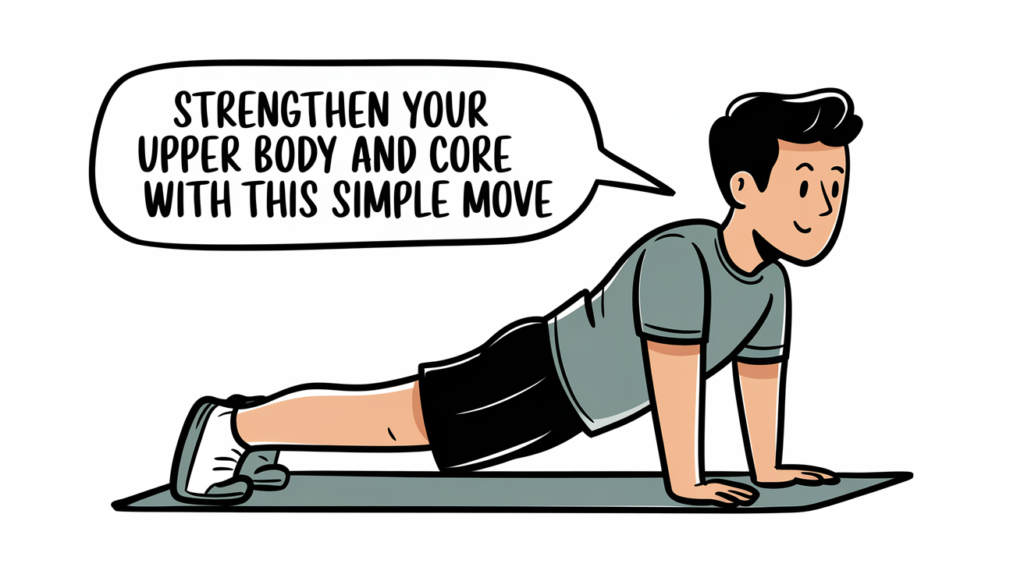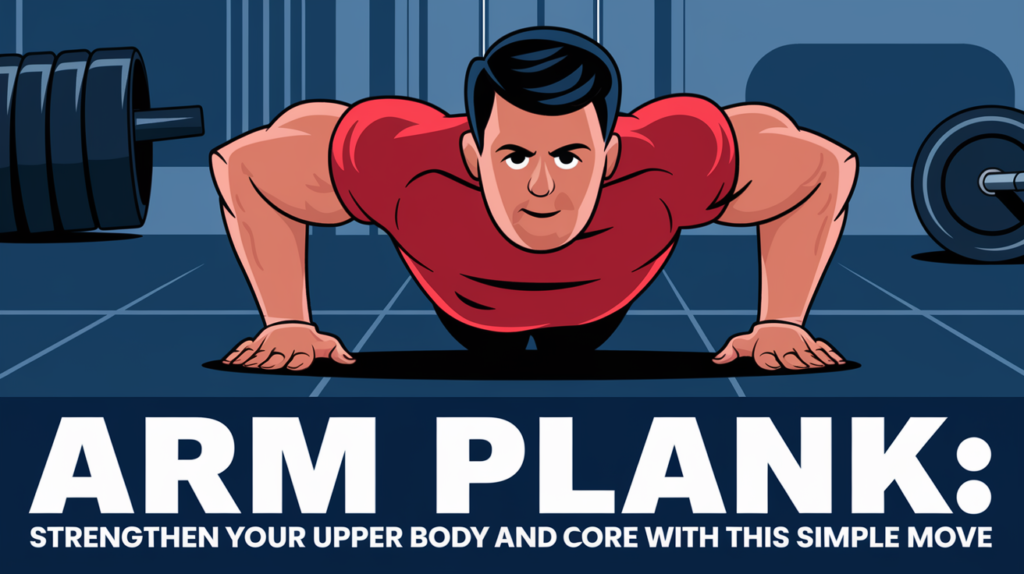In the world of fitness, the plank is a universally recognized exercise, celebrated for its effectiveness in building core strength. However, the Arm Plank variation specifically targets the upper body while still engaging the core, making it a comprehensive workout that strengthens and tones multiple muscle groups simultaneously. Whether you’re a beginner or an experienced athlete, incorporating the Arm Plank into your routine can help you achieve a stronger, more stable upper body and core. In this article, we’ll explore the benefits of the Arm Plank, how to perform it correctly, and tips for maximizing its effectiveness.
What Is the Arm Plank?

The Arm Plank is a variation of the traditional plank that places a greater emphasis on the upper body, particularly the shoulders, arms, and chest. While the core remains engaged, the Arm Plank challenges your upper body strength as you hold the position, making it an excellent exercise for those looking to build both core and upper body stability.
How It Works
In the Arm Plank, your body is supported by your hands and toes, with your arms fully extended and your body forming a straight line from head to heels. This position requires significant strength and endurance in the shoulders, triceps, and chest, while also engaging the core to maintain stability.
Benefits of the Arm Plank

The Arm Plank offers several benefits that make it a valuable addition to any workout routine:
1. Upper Body Strength
The Arm Plank targets the muscles in your shoulders, triceps, and chest, helping to build strength and endurance in these areas. Over time, regularly performing this exercise can lead to more defined and toned upper body muscles.
2. Core Stability
While the focus is on the upper body, the Arm Plank also engages the core muscles, including the rectus abdominis, transverse abdominis, and obliques. This improves core stability, which is essential for maintaining balance and proper posture.
3. Improved Posture
A strong core and upper body support better posture, reducing the risk of back pain and improving overall body alignment. By strengthening the muscles that support your spine, the Arm Plank can help you stand taller, sit straighter, and move more efficiently throughout your day.
4. Increased Endurance
Holding the Arm Plank for extended periods requires significant muscular endurance, particularly in the shoulders and core. Over time, practicing this exercise can enhance your stamina, allowing you to perform other physical activities with greater ease and less fatigue.
5. Full-Body Engagement

Although the primary focus of the Arm Plank is on the upper body and core, it also engages muscles in the legs, glutes, and lower back. This full-body engagement makes the Arm Plank an efficient exercise that delivers comprehensive benefits in a short amount of time.
6. Mental Toughness
Holding the Arm Plank requires focus, determination, and mental resilience. As you push through the challenge of maintaining the position, you build mental toughness that can translate into other areas of your life, helping you stay disciplined and motivated.
How to Perform the Arm Plank Correctly

To maximize the benefits of the Arm Plank and avoid injury, it’s crucial to perform the exercise with proper form. Follow these steps to ensure you’re doing it correctly:
1. Starting Position
- Begin by kneeling on the floor or a mat.
- Place your hands directly under your shoulders, with your fingers spread wide for stability.
- Step your feet back, one at a time, until your body forms a straight line from head to heels.
2. Engage Your Core
- Pull your belly button toward your spine to engage your core muscles.
- Keep your glutes tight and your hips level, ensuring that your body remains in a straight line.
3. Maintain Proper Alignment
- Your shoulders should be directly above your wrists, and your neck should remain neutral, with your gaze focused slightly ahead of you.
- Avoid letting your hips sag or lift too high—this will ensure that your core is fully engaged and that you’re not placing undue stress on your lower back.
4. Hold the Position
- Hold the Arm Plank for as long as you can while maintaining proper form. Beginners may start with 20-30 seconds, gradually increasing the duration as strength and endurance improve.
- Breathe steadily throughout the exercise, inhaling deeply through your nose and exhaling through your mouth.
5. Rest and Repeat
- After completing your hold, lower your body back to the floor and rest for a moment before repeating the exercise.
- Aim for 2-3 sets, depending on your fitness level.
Tips for Maximizing the Effectiveness of the Arm Plank
To get the most out of your Arm Plank practice, consider the following tips:
1. Focus on Form
Proper form is key to getting the most benefits from the Arm Plank and preventing injury. If you notice your form slipping, take a break, reset, and try again. Quality is more important than quantity, especially when it comes to core exercises.
2. Gradually Increase Duration
As you become more comfortable with the Arm Plank, gradually increase the duration of your holds. This progressive overload will help you build strength and endurance over time.
3. Incorporate Variations
To keep your routine interesting and target different muscle groups, incorporate variations of the Arm Plank. Some options include:
- Plank with Shoulder Taps: Lift one hand off the ground and tap the opposite shoulder, alternating sides while maintaining your plank position.
- Plank with Leg Lift: Lift one leg off the ground, keeping it straight and in line with your body, then switch legs.
- Side Plank: Rotate into a side plank by shifting your weight onto one arm and stacking your feet, then lift your opposite arm toward the ceiling.
4. Use a Mirror or Partner
To ensure that you’re maintaining proper alignment, consider using a mirror or asking a workout partner to check your form. This feedback can help you make necessary adjustments and avoid common mistakes.
5. Stay Consistent
Consistency is key when it comes to building strength and seeing results. Incorporate the Arm Plank into your routine at least 2-3 times per week, and you’ll notice improvements in your core and upper body strength over time.
Incorporating the Arm Plank into Your Workout Routine
The Arm Plank is a versatile exercise that can be easily integrated into various workout routines. Here are some ideas for incorporating it:
1. Warm-Up or Cool-Down
Use the Arm Plank as part of your warm-up to activate your core and upper body before more intense exercises. Alternatively, include it in your cool-down routine to engage your muscles one last time before finishing your workout.
2. Core Workouts
Add the Arm Plank to your core workout routine as a foundational exercise. Perform 2-3 sets, holding each plank for 30-60 seconds, and pair it with other core exercises like Russian twists, leg raises, or bicycle crunches.
3. Strength Training Circuits
Incorporate the Arm Plank into a full-body strength training circuit. Combine it with exercises like push-ups, squats, and lunges for a comprehensive workout that targets multiple muscle groups.
4. Active Recovery
On active recovery days, perform the Arm Plank as a low-impact exercise that still challenges your core and upper body. This can help maintain your fitness levels while giving your body a break from more intense workouts.
Conclusion: Strengthen Your Upper Body and Core with the Arm Plank
The Arm Plank is a simple yet highly effective exercise for building upper body strength and core stability. By incorporating this move into your workout routine, you’ll enhance your posture, improve your balance, and develop a stronger, more resilient body. Whether you’re new to fitness or looking to elevate your current routine, the Arm Plank offers a powerful tool for achieving your goals. With consistent practice and attention to form, you’ll be able to master this exercise and enjoy the many benefits it brings to your overall health and well-being.






